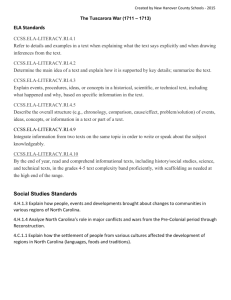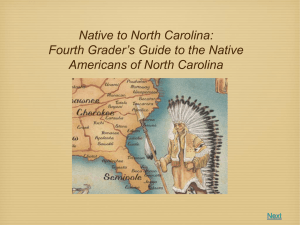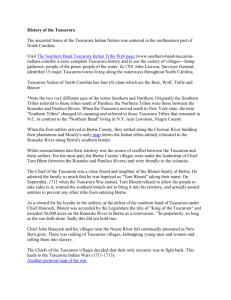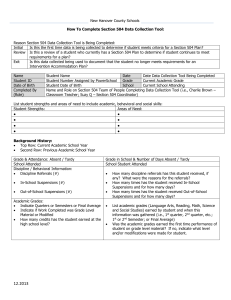Source 1 - New Hanover County Schools
advertisement
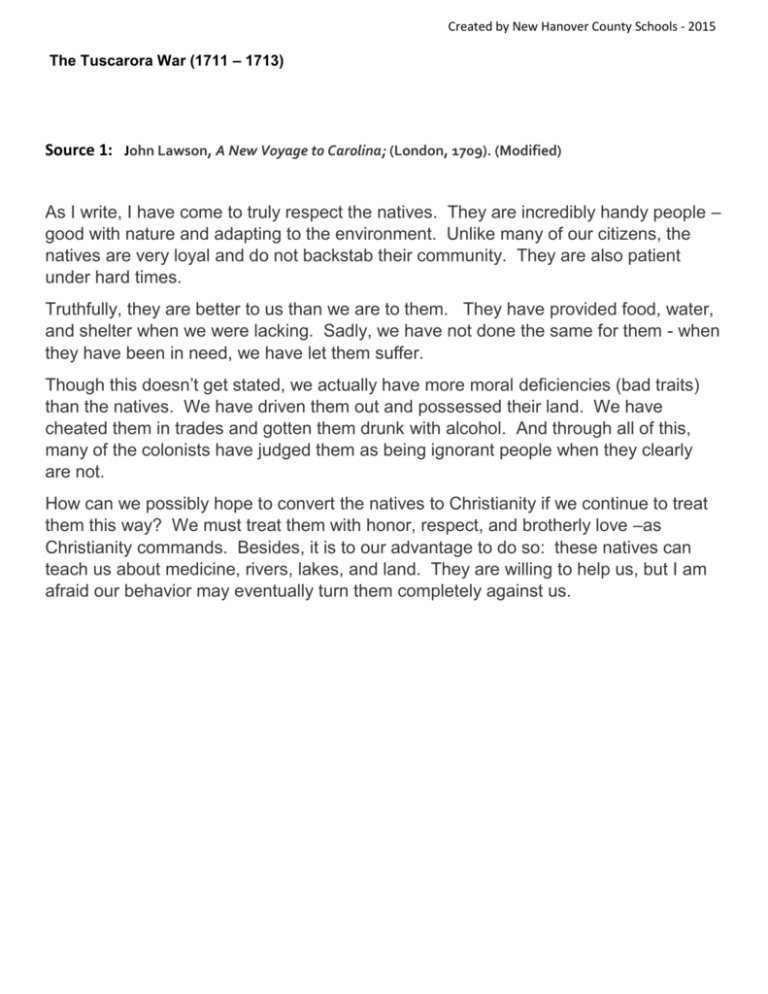
Created by New Hanover County Schools - 2015 The Tuscarora War (1711 – 1713) Source 1: John Lawson, A New Voyage to Carolina; (London, 1709). (Modified) As I write, I have come to truly respect the natives. They are incredibly handy people – good with nature and adapting to the environment. Unlike many of our citizens, the natives are very loyal and do not backstab their community. They are also patient under hard times. Truthfully, they are better to us than we are to them. They have provided food, water, and shelter when we were lacking. Sadly, we have not done the same for them - when they have been in need, we have let them suffer. Though this doesn’t get stated, we actually have more moral deficiencies (bad traits) than the natives. We have driven them out and possessed their land. We have cheated them in trades and gotten them drunk with alcohol. And through all of this, many of the colonists have judged them as being ignorant people when they clearly are not. How can we possibly hope to convert the natives to Christianity if we continue to treat them this way? We must treat them with honor, respect, and brotherly love –as Christianity commands. Besides, it is to our advantage to do so: these natives can teach us about medicine, rivers, lakes, and land. They are willing to help us, but I am afraid our behavior may eventually turn them completely against us. Created by New Hanover County Schools - 2015 Source 2: Fictional story set at a Tuscarora Camp – the natives are having a discussion on what to do with the white settlers. “The white man keeps coming,” says Running Deer. “They have expanded into what the white man calls New Bern. Soon, we will have no land in which to hunt or raise our families.” “What do you think we should do?” ask Stands With A Fist. “Running Deer answers: “The only thing we can do: kill them.” “No” – shouts Spirit Man – “That will lead to more problems.” “There are too many white men now – we cannot kill them all. War will lead to our destruction.” “Maybe”, Running Deer shouts, “but we are dying now. Don’t you see? We have already lost hunting land and had our people sold into slavery. If we do not make a stand now, our tribe will die.” Spirit Man then says, “Maybe we can sign a peace treaty with the whites in New Bern? Not all of them are greedy.” “Treaties will not work” Running Deer demands. “The Whites have already broken promises – we cannot trust their word.” Running Deer then puts out a plan: “Let us pretend everything is okay with the whites and we can go into their various villages and surprise attack them on September 22nd (1711).” Stands With Fist then says, “I fear Running Deer may be right. Let us put his plan to a vote.” The votes of the Tuscarora are counted and Running Deer’s plan for war on September 22 is agreed to. The surprise attack is set. nd Source: Written by the New Hanover County Schools Instructional Services Department - 2015 Created by New Hanover County Schools - 2015 Source 3: Tuscarora Camp Baron Christoph Von Graffenried’s drawing, The Death of John Lawson, depicts Von Graffenried, his servant, and John Lawson being held captive by Tuscarora Indians shortly before Lawson’s death. In the center of the drawing, the three prisoners sit, hands bound, near a fire. The Tuscarora dance and play drums in a semi-circle on the right, and one Indian stands in the center, holding what appear to be a hatchet and a knife, near two dead animals impaled on sticks. Four Tuscarora in a line on the left seem to be guarding over the prisoners. A few Indian buildings are scattered across the top and bottom of the drawing. Source: Drawing by Baron Christoph Von Graffenried. Image courtesy of North Carolina State Archives, Division of Archives and History. Created by New Hanover County Schools - 2015 Source 4: Letter from Major Christopher Gale, November 2, 1711 (Modified) Dear South Carolina Governor and Council, This lettering is arriving under the most dire of circumstances – therefore, I will spare any sort of polite introduction. I am alive right now only because of the incredible hand of God. You see, I was meeting up with John Lawson and Baron Christoph von Graffenreid [co-founders of the New Bern settlement) to scout additional land areas. Shortly before we were to leave, I received a note saying that my wife and brother were desperately sick and I left Lawson and the Baron to try and take care of them. According to the Baron, shortly after he and Lawson started exploring various lands, they were captured by the Tuscarora and brought to their camp. After several rounds of discussion, they decided to execute John Lawson by roasting him over a fire. The Tuscarora spared the Baron, but they kept him prisoner until after their attack upon the colonial settlements were complete. I need to tell you that the Tuscarora have butchered many of the colonists. Apparently they started these attacks on September 22nd (1711). I will spare you most of the gory details, but at least one of these attacks, I feel compelled to describe – so you will get an idea of what we are up against and hopefully help us. I was on my way back to the village – when I noticed things were quiet. I did not hear children playing or people laughing. When I got closer, I realized I didn’t see any signs of life and our entire village looked like it had been hit by a hurricane. I walked closer and what I saw shocked me – shocked me more than anything I have ever seen in my life. Men, women and children had been killed. Bodies everywhere – piled up. It smelled. There were blood and body parts missing. I am telling you it was the worst thing I have ever seen in my life. I wish I could tell you that we were planning an attack against them, but they destroyed our village so badly, we do not have the manpower to strike back. Most of the villagers are hiding and not working as a team. The colony needs immediate help or we will probably all parish. Can you send an army to help drive out these savages? Because of safety and fear, we cannot even bury our dead. Your sincerely affectionate brother, Christopher Gale Created by New Hanover County Schools - 2015 Source 5: (Modified) Christopher von Graffenried’s Letter regarding the middle and ending of the Tuscarora War Christoph von Graffenried's Account of the Founding of New Bern (Raleigh: Edwards & Broughton Printing, 1920). To be honest, North Carolina was so devastated and unprepared for war, we did not know where or how to begin. You cannot wage war if you are starving and we had very little food. However, some neighboring North Carolina towns and communities did agree to provide us with rations. We also lacked weapons, gunpowder, and soldiers. We asked other NC communities for guns, but they would only supply if we had money and since we were in debt, we could not afford to pay. Unbelievably, some of our male citizens were too afraid to fight – decided to just try and defend their own home – hoping the Tuscarora would not attack them. We asked VA for weapons and soldiers and they at first appeared willing to help our colony. However, VA soon acquired about how we would pay them and once they realized we could not guarantee it, they decided not to help. Amazingly, South Carolina did agree to help! They sent 50 colonial soldiers and 800 SC Indians all under the command of Colonel John Barnwell. We appreciated their help, but they were ruthless. They killed many Tuscarora and burned one alive in front of witnesses. Many of the Tuscarora fled into a native fort. We attempted to take the fort, but our first attempt failed – largely because the attacking force disobeyed orders and attacked at the wrong time and the wrong place. A few days later, we tried again. We fired guns into the fort and used grenades – this caused the Tuscarora to ask for a truce. Some did not want to accept the truce, but the Tuscarora were holding some of our hostages and threatened to kill them if we did not accept. Sadly, John Barnwell, the commander from South Carolina, believed he had been disrespected and unappreciated by the NC government and citizens. In order to make some money, Barnwell took some Tuscarora as slaves – thus causing the war to start up again. We were outraged by this behavior because it caused the Tuscarora not to trust any of us. Once again, we found ourselves helpless. With nowhere to turn, we wrote South Carolina for help. Unbelievably they agreed to help. They again sent Indians and SC soldiers, but they were placed under the command of Captain Moore – a much more reasonable person. We again marched on the major Tuscarora fort and eventually took control. The natives showed incredible courage – fighting when they were badly wounded. About 900 Tuscarora were either killed or captured – that includes women and children. Peace was then more or less back in the colony and the remaining Tuscarora moved out of the colony – never to return. I believe this to be an accurate account of what happened – a tragic and bloody event for everyone involved. Created by New Hanover County Schools - 2015 Document Source Analysis Sheet Source or Text Source 1: The John Lawson Letter Source 2: Fictional Story on the Tuscarora meeting Source 3: Image – Tuscarora Camp Source 4: Christopher Gale Letter Source 5: Graffenried Letter What do you see (what did you see at first and what do you see after reading or viewing this source again)? Why do you think somebody created this source? What else would you like to know about this source to have a better understanding of this event? Created by New Hanover County Schools - 2015 Document Source Analysis Sheet Source or Text Source 1: The John Lawson Letter Source 2: Fictional Story on the Tuscarora meeting Source 3: Image – Tuscarora Camp Source 4: Christopher Gale Letter Source 5: Graffenried Letter Who created this piece, when was it created, and what point was the creator trying to get readers to understand? What was implied by the creator and what information may have been left out or not considered? What else would you like to know about this source to have a better understanding of this event?
